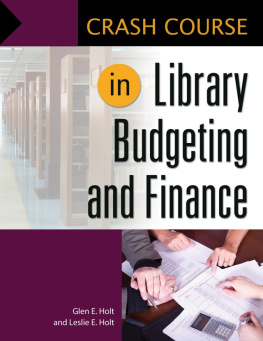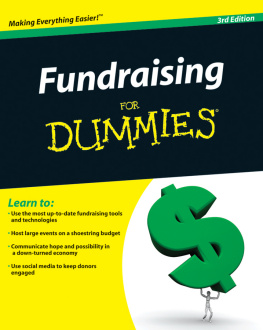Successful Library Fundraising
Successful Library Fundraising
Best Practices
Edited by M. Sandra Wood
ROWMAN & LITTLEFIELD
Lanham Boulder New York London
Published by Rowman & Littlefield
A wholly owned subsidiary of The Rowman & Littlefield Publishing Group, Inc.
4501 Forbes Boulevard, Suite 200, Lanham, Maryland 20706
www.rowman.com
16 Carlisle Street, London W1D 3BT, United Kingdom
Copyright 2014 by Rowman & Littlefield
All rights reserved. No part of this book may be reproduced in any form or by any electronic or mechanical means, including information storage and retrieval systems, without written permission from the publisher, except by a reviewer who may quote passages in a review.
British Library Cataloguing in Publication Information Available
Library of Congress Cataloging-in-Publication Data
Successful library fundraising : best practices / edited by M. Sandra Wood.
pages cm
Includes bibliographical references and index.
ISBN 978-1-4422-3738-4 (cloth : alk. paper) ISBN 978-1-4422-3169-6 (pbk. : alk. paper) ISBN 978-1-4422-3170-2 (electronic) 1. Library fund raisingUnited States. 2. Library fund raisingCase studies. I. Wood, M. Sandra.
Z683.2.U6S83 2014
025.11dc23 2014011548
 The paper used in this publication meets the minimum requirements of American National Standard for Information SciencesPermanence of Paper for Printed Library Materials, ANSI/NISO Z39.48-1992.
The paper used in this publication meets the minimum requirements of American National Standard for Information SciencesPermanence of Paper for Printed Library Materials, ANSI/NISO Z39.48-1992.
Printed in the United States of America
Preface
Raising funds to support a librarywhether its an academic, public, or special libraryis an ongoing issue; its at the heart of the viability and future success of all libraries. And while libraries strive to provide the services, programs, and facilities that their patrons and communities want and need, funding is needed before these services, programs, and facilities can be offered.
Libraries obtain funding for operations in many waysfor example, through an institutional budget for academic libraries, or as part of a city budget for some public libraries. Some libraries organize annual campaigns for operations; some raise funds through book sales or special events. Funding is also needed for new buildings (capital campaigns), for special projects or services, and more. The list could go on and on. But, in most cases, libraries actively need to search for ways to fund their operation in the short and long term.
Successful Library Fundraising: Best Practices draws on the experience of librarians at twelve institutions to offer suggestions for raising funding and donations to cover operating expenses, special projects and services, handling capital campaigns, generating bequests and endowments, and working with library boards and foundations. All of these authors have successfully generated money and/or donations for their respective libraries utilizing both traditional approaches (e.g., book sales or author events) and newer electronic methods (e.g., websites, social media, and crowdfunding). Most have used a multi-pronged approach, looking at both immediate and long-term needs. All librarians should be able to take something from these successful efforts and apply them to their own libraries.
Organization
Successful Library Fundraising: Best Practices consists of twelve chapters covering a wide range of funding activities by all types of libraries, both large and small, and all are written by experienced library fundraisers. The arrangement of the chapters reflects the variety, moving between public, academic, and special libraries, from traditional fundraising efforts to newer ones using online sourcing, from focused efforts to multifaceted ones.
In Chapter 1, Andy Kahan describes the Author Events Series at the Free Library of Philadelphia, provided through its foundation. This program, developed over many years, brings in nationally known authors and has been extended to larger events to fund library programs. Author Events celebrates its twentieth year in 2014; other events include a teen authors series and the Philadelphia Book Festival.
Tom Hadzor and Kurt Cumiskey describe the overall fundraising initiative at Duke University Libraries. Their program is multifaceted, including major gift prospecting, an annual fund, planned giving, and more. Their fundraising activities involve both traditional methods and newer technologies such as social media and utilizing the librarys website, all of which are described in Chapter 2.
Jane Rutledge details the well-developed book sale program that provides major funding for the Tippecanoe County Public Library in West Lafayette, Indiana. Her account of how to run a book sale program provides wonderful tips for libraries that also use book sales to generate operating funds. She offers best practices and suggestions that include how to handle donations, pricing, organizing the sale, publicity, and working with volunteers and book dealers.
In Chapter 4, Dwain Teague tackles the difficult task of making discovery callsthat is, cold calling prospective donors to help generate both current and future funding for the library. He provides sample e-mails and snail mails that will help break the ice for these cold calls. In addition, he offers best practices to help librarians get started with building their donor bases, including meeting with prospects visiting the institution, meeting outside the library, and working with library staff.
Chapters 5 and 6 describe the Campaign for Seattles Public Libraries, a major fundraising effort by the Seattle Public Library Foundation to raise capital funding for the SPLs main library and its branches, and for special programming and an endowment. In Chapter 5, Terry Collings describes the early years of the foundation and its structure, along with the initial campaign; as he shows, the campaign was years in the making. While not all libraries will have access to the major corporate donors, as was the case for the SPL, the campaign methods and practices described here are transferable for smaller-scale campaigns. Jonna Ward continues the SPL story in Chapter 6, describing how the Seattle Public Library Foundation then took its fundraising campaign to the community, seeking smaller donations from individuals and library patrons, thus involving everyone in this community effort. She provides a simplified work plan to help others with activities such as telefunding and direct mail.
Librarians at the Health Science Center Library at the University of Florida have used grantsboth large and smallto provide programming and help fund staff. In Chapter 7, Hannah Norton and colleagues describe how initial success in finding grant support led to additional grant opportunities from within the institution and from outside sources, and outreach to other departments also opened up new funding. They offer a set of lessons learned to help others who seek to fund programs and services through grants.
In Chapter 8, Christina Muracco of the Smithsonian Libraries describes working with a librarys board of directors. She covers the various roles of the board (and, specifically, its involvement in fundraising). Throughout the chapter she provides best practices for both board members and librarians working with board members.
Karlene Jennings tackles what some librarians may view as a difficult taskplanned giving. In Chapter 9, she describes the need for tact and respect in working with potential libraries, looking at the long-range goal fundraising activity of generating bequests for the library. She covers basics and best practices for dealing with planned giving donors.
In Chapter 10, Sidney Berger describes fundraising efforts in special collections. He points out that fundraising is not always a money-raising effortin some cases (and especially for special collections), it may be about outreach to generate donations of collections. He offers best practices for outreach to book dealers, collectors, authors, and more. This chapter highlights a case history of the exhibition of books from the University of California, Riverside (which houses the J. Lloyd Eaton Collection of Science Fiction, Fantasy, Horror, and Utopia), at the West Coast book fair of the Antiquarian Booksellers Association of America, which generated many donations to the library.
Next page









 The paper used in this publication meets the minimum requirements of American National Standard for Information SciencesPermanence of Paper for Printed Library Materials, ANSI/NISO Z39.48-1992.
The paper used in this publication meets the minimum requirements of American National Standard for Information SciencesPermanence of Paper for Printed Library Materials, ANSI/NISO Z39.48-1992.